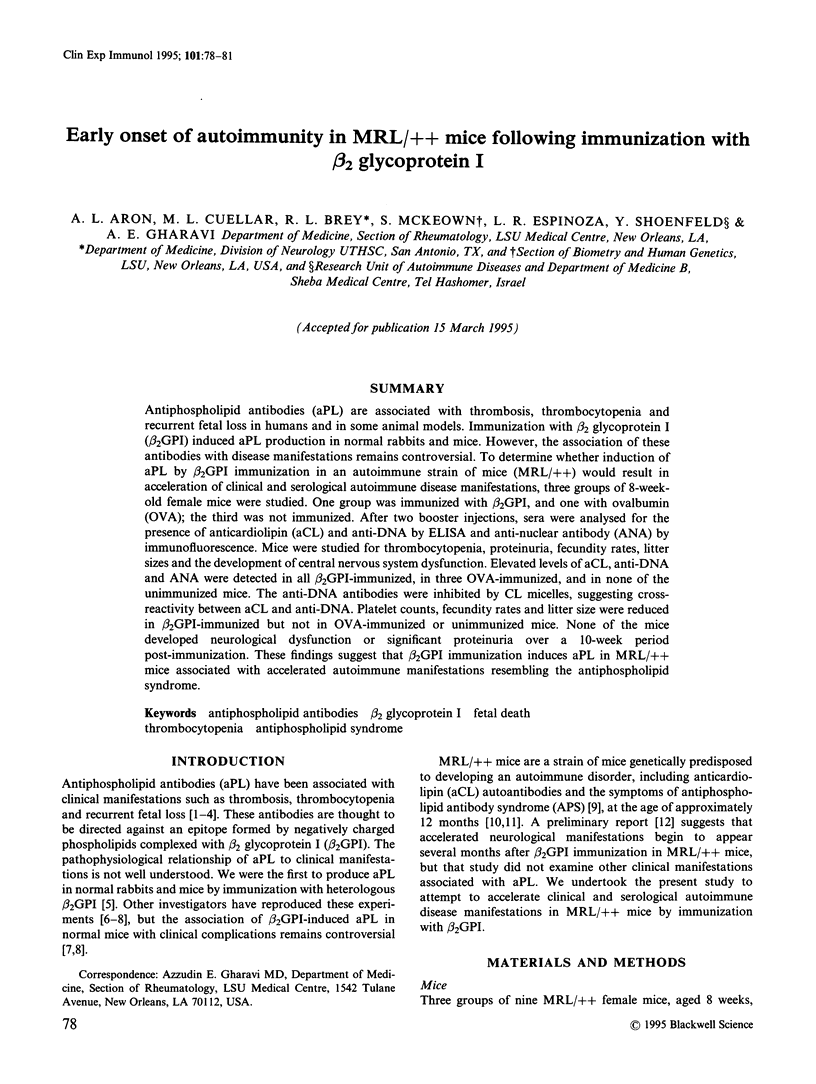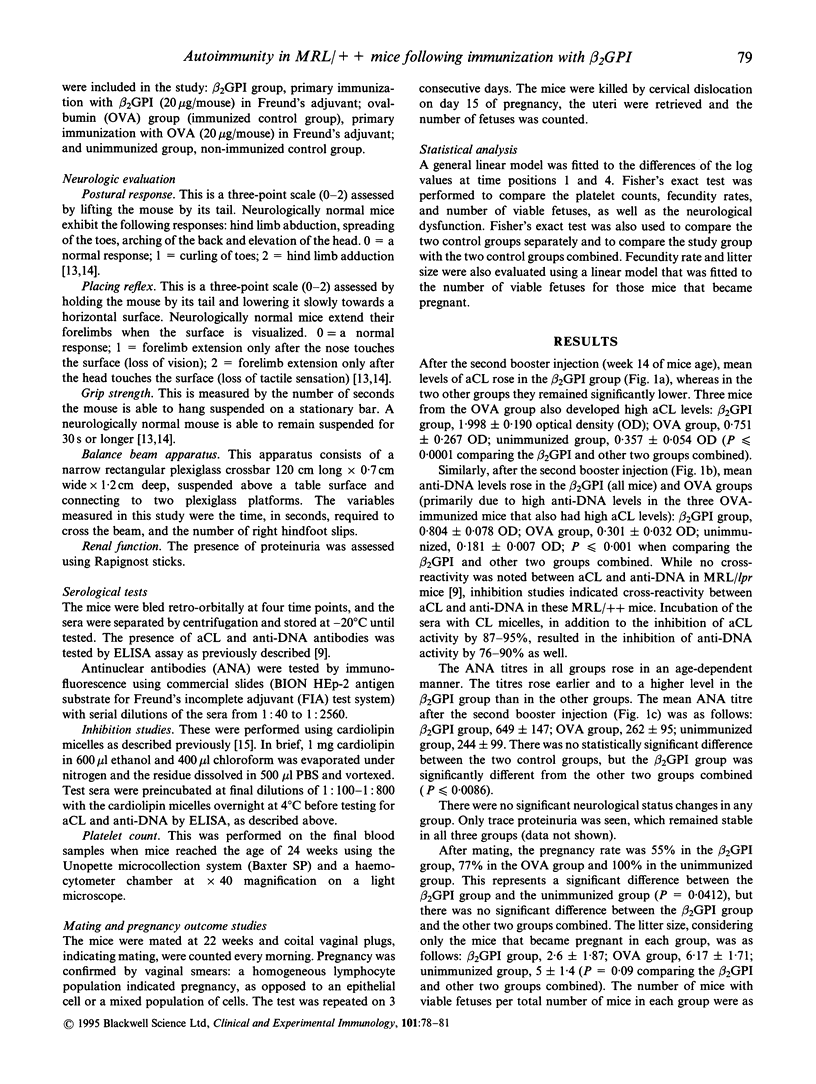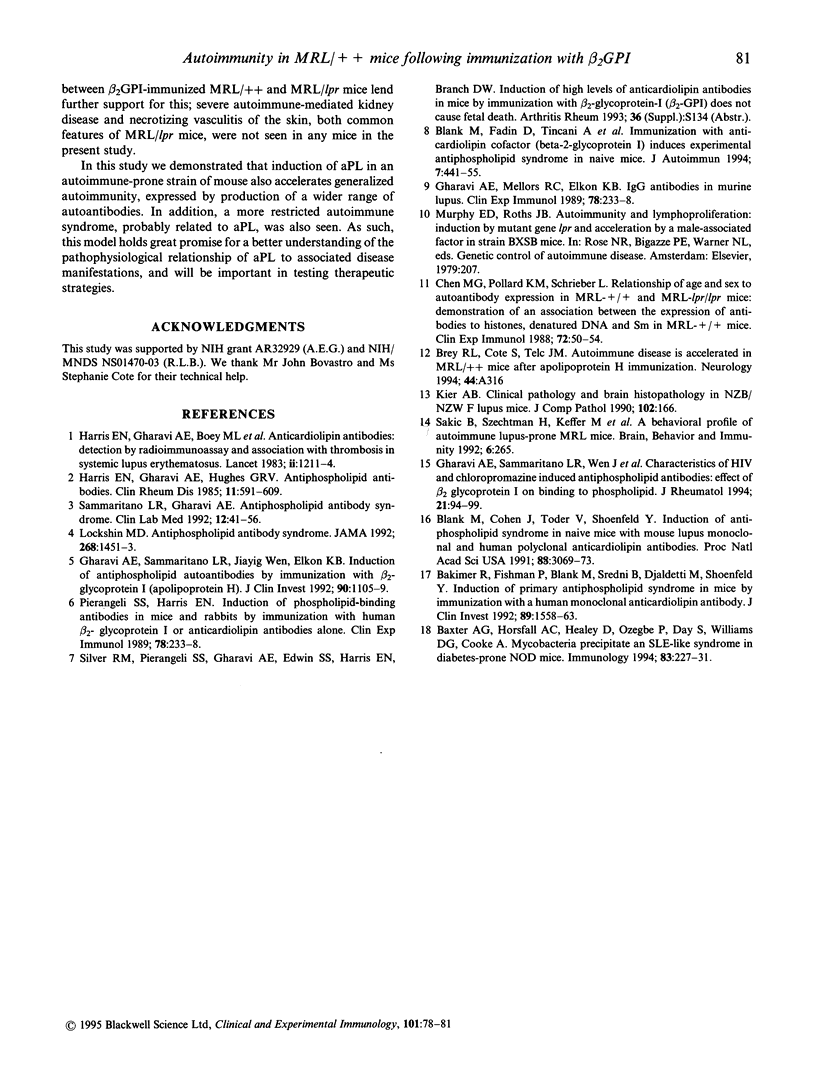Abstract
Antiphospholipid antibodies (aPL) are associated with thrombosis, thrombocytopenia and recurrent fetal loss in humans and in some animal models. Immunization with beta 2 glycoprotein I (beta 2GPI) induced aPL production in normal rabbits and mice. However, the association of these antibodies with disease manifestations remains controversial. To determine whether induction of aPL by beta 2GPI immunization in an autoimmune strain of mice (MRL/++) would result in acceleration of clinical and serological autoimmune disease manifestations, three groups of 8-week-old female mice were studied. One group was immunized with beta 2GPI, and one with ovalbumin (OVA); the third was not immunized. After two booster injections, sera were analysed for the presence of anticardiolipin (aCL) and anti-DNA by ELISA and anti-nuclear antibody (ANA) by immunofluorescence. Mice were studied for thrombocytopenia, proteinuria, fecundity rates, litter sizes and the development of central nervous system dysfunction. Elevated levels of aCL, anti-DNA and ANA were detected in all beta 2GPI-immunized, in three OVA-immunized, and in none of the unimmunized mice. The anti-DNA antibodies were inhibited by CL micelles, suggesting cross-reactivity between aCL and anti-DNA. Platelet counts, fecundity rates and litter size were reduced in beta 2GPI-immunized but not in OVA-immunized or unimmunized mice. None of the mice developed neurological dysfunction or significant proteinuria over a 10-week period post-immunization. These findings suggest that beta 2GPI immunization induces aPL in MRL/++ mice associated with accelerated autoimmune manifestations resembling the antiphospholipid syndrome.
Full text
PDF



Selected References
These references are in PubMed. This may not be the complete list of references from this article.
- Bakimer R., Fishman P., Blank M., Sredni B., Djaldetti M., Shoenfeld Y. Induction of primary antiphospholipid syndrome in mice by immunization with a human monoclonal anticardiolipin antibody (H-3). J Clin Invest. 1992 May;89(5):1558–1563. doi: 10.1172/JCI115749. [DOI] [PMC free article] [PubMed] [Google Scholar]
- Baxter A. G., Horsfall A. C., Healey D., Ozegbe P., Day S., Williams D. G., Cooke A. Mycobacteria precipitate an SLE-like syndrome in diabetes-prone NOD mice. Immunology. 1994 Oct;83(2):227–231. [PMC free article] [PubMed] [Google Scholar]
- Blank M., Cohen J., Toder V., Shoenfeld Y. Induction of anti-phospholipid syndrome in naive mice with mouse lupus monoclonal and human polyclonal anti-cardiolipin antibodies. Proc Natl Acad Sci U S A. 1991 Apr 15;88(8):3069–3073. doi: 10.1073/pnas.88.8.3069. [DOI] [PMC free article] [PubMed] [Google Scholar]
- Blank M., Faden D., Tincani A., Kopolovic J., Goldberg I., Gilburd B., Allegri F., Balestrieri G., Valesini G., Shoenfeld Y. Immunization with anticardiolipin cofactor (beta-2-glycoprotein I) induces experimental antiphospholipid syndrome in naive mice. J Autoimmun. 1994 Aug;7(4):441–455. doi: 10.1006/jaut.1994.1032. [DOI] [PubMed] [Google Scholar]
- Cohen M. G., Pollard K. M., Schrieber L. Relationship of age and sex to autoantibody expression in MRL-+/+ and MRL-lpr/lpr mice: demonstration of an association between the expression of antibodies to histones, denatured DNA and Sm in MRL-+/+ mice. Clin Exp Immunol. 1988 Apr;72(1):50–54. [PMC free article] [PubMed] [Google Scholar]
- Gharavi A. E., Mellors R. C., Elkon K. B. IgG anti-cardiolipin antibodies in murine lupus. Clin Exp Immunol. 1989 Nov;78(2):233–238. [PMC free article] [PubMed] [Google Scholar]
- Gharavi A. E., Mellors R. C., Elkon K. B. IgG anti-cardiolipin antibodies in murine lupus. Clin Exp Immunol. 1989 Nov;78(2):233–238. [PMC free article] [PubMed] [Google Scholar]
- Gharavi A. E., Sammaritano L. R., Wen J., Elkon K. B. Induction of antiphospholipid autoantibodies by immunization with beta 2 glycoprotein I (apolipoprotein H). J Clin Invest. 1992 Sep;90(3):1105–1109. doi: 10.1172/JCI115927. [DOI] [PMC free article] [PubMed] [Google Scholar]
- Gharavi A. E., Sammaritano L. R., Wen J., Miyawaki N., Morse J. H., Zarrabi M. H., Lockshin M. D. Characteristics of human immunodeficiency virus and chlorpromazine induced antiphospholipid antibodies: effect of beta 2 glycoprotein I on binding to phospholipid. J Rheumatol. 1994 Jan;21(1):94–99. [PubMed] [Google Scholar]
- Harris E. N., Gharavi A. E., Boey M. L., Patel B. M., Mackworth-Young C. G., Loizou S., Hughes G. R. Anticardiolipin antibodies: detection by radioimmunoassay and association with thrombosis in systemic lupus erythematosus. Lancet. 1983 Nov 26;2(8361):1211–1214. doi: 10.1016/s0140-6736(83)91267-9. [DOI] [PubMed] [Google Scholar]
- Harris E. N., Gharavi A. E., Hughes G. R. Anti-phospholipid antibodies. Clin Rheum Dis. 1985 Dec;11(3):591–609. [PubMed] [Google Scholar]
- Lockshin M. D. Antiphospholipid antibody syndrome. JAMA. 1992 Sep 16;268(11):1451–1453. [PubMed] [Google Scholar]
- Sakić B., Szechtman H., Keffer M., Talangbayan H., Stead R., Denburg J. A. A behavioral profile of autoimmune lupus-prone MRL mice. Brain Behav Immun. 1992 Sep;6(3):265–285. doi: 10.1016/0889-1591(92)90048-s. [DOI] [PubMed] [Google Scholar]
- Sammaritano L. R., Gharavi A. E. Antiphospholipid antibody syndrome. Clin Lab Med. 1992 Mar;12(1):41–59. [PubMed] [Google Scholar]


